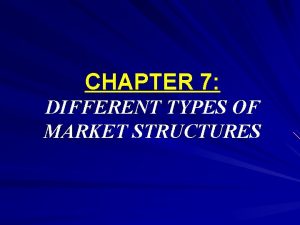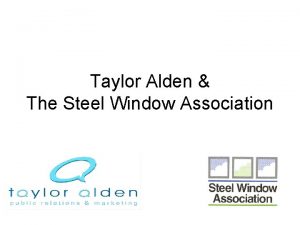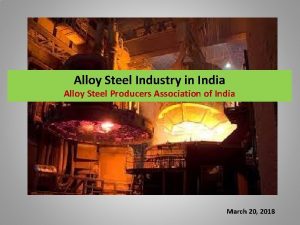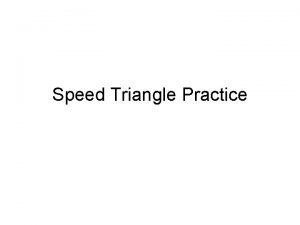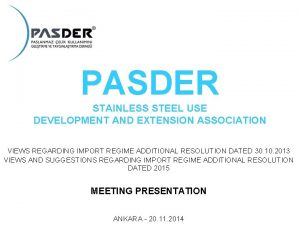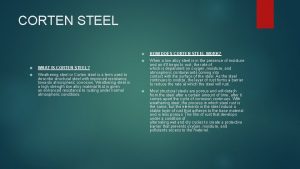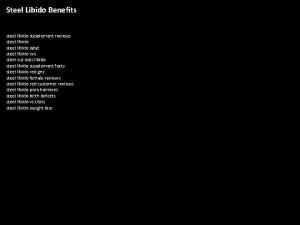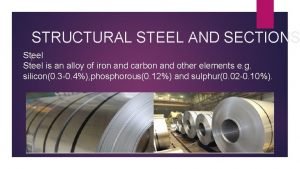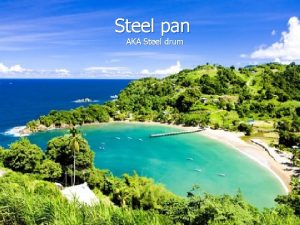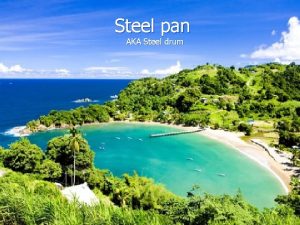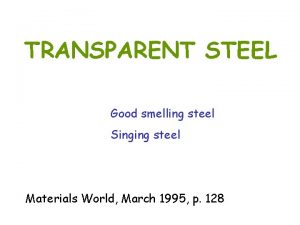STEEL According to the World Steel Association there











![PHYSICAL PROPERTIES [ BIS 1786 – 1985 ] Proof Stress/Yield Stress; percentage elongation and PHYSICAL PROPERTIES [ BIS 1786 – 1985 ] Proof Stress/Yield Stress; percentage elongation and](https://slidetodoc.com/presentation_image_h2/0dbf28565e66b7dcf7de4931736c75f7/image-12.jpg)

- Slides: 13

STEEL • According to the World Steel Association, there are over 3, 500 different grades of steel, encompassing unique physical, chemical and environmental properties. • In essence, steel is composed of iron and carbon, although it is the amount of carbon, as well as the level of impurities and additional alloying elements that determines the properties of each steel • The carbon content in steel can range from 0. 1 -1. 5%, but the most widely used grades of Steel contain only 0. 1 -0. 25% carbon. • Elements such as manganese, phosphorus and sulphur are found in all grades of steel, whereas manganese provides beneficial effects, Phosphorus and Sulphur are deleterious to Steel’s Strength and Durability • Different types of steel are produced according to the properties required for their application, and various grading systems are used to distinguish steels based on these properties. • According to the American Iron and Steel Institute (AISI), steels can be categorized into four groups based on their chemical Compositions: 1. Carbon Steels 2. Alloy Steels 3. Stainless Steels 4. Tool Steels broadly 1

Carbon Steels: • • Carbon steels contain trace amounts of alloying elements and account for 90% of total steel production. Carbon steels can be further categorized into three groups depending on their carbon content: 1. Low Carbon Steels/Mild Steels contain up to 0. 3% carbon 2. Medium Carbon Steels contain 0. 3 – 0. 6% carbon 3. High Carbon Steels contain more than 0. 6% carbon Alloy Steels: • Alloy steels contain alloying elements like: v Manganese, v Silicon, v Nickel, v Titanium, v Copper, v Chromium And Aluminum in varying proportions in order to manipulate the steel's properties, such as: : Hardenability, Corrosion Resistance, Strength, Formability, Weldability Or Ductility. 2

• Applications for alloys steel include: v Pipelines, v Auto Parts, v Transformers, v Power generators and v Electric motors. Stainless Steels: • • • Stainless steels generally contain between 10 -20% chromium as the main alloying element and are valued for high corrosion resistance. With over 11% chromium, steel is about 200 times more resistant to corrosion than mild steel. These steels can be divided into three groups based on their crystalline structure: a. Austenitic: • Austenitic steels are non-magnetic and non heat-treatable, and generally contain: v 18% chromium v 8% nickel and v less than 0. 8% carbon Austenitic steels form the largest portion of the global stainless steel market and are often used in: v Food Processing Equipment, v Kitchen Utensils and v Piping. • 3

b. • v v v • Ferritic: Ferritic steels contains: Trace amounts of Nickel, 12 -17% Chromium, less than 0. 1% Carbon, along with other alloying elements: , Ø such as Molybdenum, Ø Aluminum or Titanium. These magnetic steels cannot be hardened with heat treatment, but can be strengthened by cold working. c. Martensitic: • Martensitic steels contain : v v v 11 -17% chromium less than 0. 4% nickel and up to 1. 2% carbon. • These magnetic and heat-treatable steels are used in knives, cutting tools, as well as dental and surgical equipment. d. • Tool Steels: Tool steels contain: v v Tungsten Molybdenum Cobalt and Vanadium in varying quantities to increase heat resistance and durability, making them ideal for cutting and drilling equipment. 4

Ø The art and technology needed for the production of iron was well developed in ancient India. Ø The Asoka pillars, such as the one situated in the Qutub Minar complex is an example of high skills of its makers. Ø The quality of iron used is so good that after more than hundred years it is still rust free. Ø However iron was not used in buildings and bridges during the ancient and medieval period because of the following reasons : 1. For Buildings and Bridges, superior quality alternative materials like very strong bricks, stones, strong and durable timber and high strength mortars were available. 2. Fairly complicated forms of construction like the variable thickness barrel roofs, circular and elliptical arches, spherical and elliptical domes and other types of structures were used. Ø A barrel shell roof made from bricks and mortar only at Bara Immambara, Lucknow is known to be the largest shell roof of its kind in the world. 5

Types of Structures : - From structural point of view v Shell Structures v Framed Structures Shell Structures : Ø These are mostly made up of plates and sheets. Ø In such structures loads are mostly taken up by plates which serves as covering material also. Ø Tanks, airplanes and shell roof coverings are some of the examples of shell structures. Ø The main advantage is the saving in the cost of the construction material. Framed Structures: Ø Framed structures consist of elongated members assembled together, such as roof truss, beams, etc. Ø In framed structures the load is mostly transmitted by the frames and the later do not act as a covering material. However, framed structures are more commonly used, as shell structures pose some difficulties. The knowledge of shell structures is not widely spread and such structures are not economical for certain layouts and spans. 6

Field of Application Shell Systems q Gas holders and tanks for the storage and distribution of gases. q Tanks and reservoirs for the storage of liquids. q Bin and bunkers for the storage of loose materials like cement, grains etc. q Ship hulls, airplane fuselage, etc. Framed Structures q Railway, highway and other large span bridges. q Very tall multistory buildings, exhibition pavilions, etc. q Hangers, shipyards, railway platforms, etc. q Transmission towers, television masts, cranes, etc. 7

Advantages and Disadvantages of Steel Structures Advantages v The ability to resist high load with a comparatively small size and lightweight of members. v Due to high density, steel is completely non porous. v The possibility of industrializing the construction work by the use of prefabricated and mechanized erection at the construction site. v A very long service life, provided care is taken. v The possibility of disassembling or replacing some steel members of a structure for strengthening purpose. Disadvantages v The main drawback of steel members is their susceptibility to corrosion. v Second drawback is its low fire resistance. v At high temperatures steel loses most of its strength, leading to excessive deformation or failure. 8

Composition and Properties of Structural Steel Ø Iron is not available in pure form in nature. Ø It has to be extracted from various iron ores in the form of Pig Iron. Ø Some of the iron ores from which the iron is extracted are: Magnetite (Fe 2 O 4) Contains 70 % – 75 % iron Hematite ( Fe 2 O 3 ) Contains about 70 % iron Iron Pyrites ( Fe. S 2 ) Contains about 47 % iron Sederite (Fe. CO 3 ) Contains about 40 % iron Pig Iron : Ø To remove impurities from the iron ore carbon and flux are added while melting it. Ø The refined product so obtained is the crudest form of iron and is called Pig Iron. Cast Iron : Ø The Pig Iron is re melted with lime stone and coke and poured into moulds of desired shapes and sizes to get cast iron. Ø Carbon varies from 2 % - 4. 5 % 9

Steel Ø The essential difference between cast iron and steel is their amount of carbon content. Ø Steel goes on becoming harder with the increase in its carbon content. Ø Up to a content of 1. 5% all the carbon gets into chemical combination with iron and none of it exists in free state. Ø If carbon content increases beyond 1. 5% then it does not combine with iron and is present as free graphite. Ø It is at this stage that the metal falls in the category of cast iron and the carbon content may be increased up to 4. 5 %. Ø Therefore for a material to be classified as steel there should be no free graphite. Depending upon the carbon content, the steel is characterized as follows 1. Mild Steel ( IS 226 – 1962 ) designated as St 42 – S 2. High Tensile Structural Steel ( IS – 961 -1962 ) designated as v St 58 – HT v St 55 – HTW 3 High Yield strength Deformed Bars (HYSD)[IS 1786 – 1985] designated as v Fe 415, Fe 500, Fe 550 10

Table 1 Chemical Composition Constituents in Percentages Designation Mild steel St 42 – S High tensile Steel St 58 – HT St 55 – HTW Carbon Sulphur Phosphorus Silicon 0. 25 0. 30 0. 22 0. 06 Sulphur & Phosphorus 0. 06 - - 0. 06 0. 0. 1 11
![PHYSICAL PROPERTIES BIS 1786 1985 Proof StressYield Stress percentage elongation and PHYSICAL PROPERTIES [ BIS 1786 – 1985 ] Proof Stress/Yield Stress; percentage elongation and](https://slidetodoc.com/presentation_image_h2/0dbf28565e66b7dcf7de4931736c75f7/image-12.jpg)
PHYSICAL PROPERTIES [ BIS 1786 – 1985 ] Proof Stress/Yield Stress; percentage elongation and tensile strength for all sizes of deformed bars/wires determined in accordance with IS 1608 – 1972 and read in conjunction with IS 226 – 1975 shall be as given in table 2 Table 2 Mechanical Properties of High Strength Deformed Bars and Wires S. No 1 2 3 Property 0. 2 percent proof/Yield Stress, Min, N/mm 2 Elongation, Percent, Min Tensile Strength, Min. Grade Fe 415 Fe 500 Fe 550 415 500 550 14. 5 12 8 10 percent more 8 percent more than the actual Yield stress but not less than 2 485 N/mm 545 N/mm 2 6 percent more than the actual Yield stress but not less than 585 N/mm 2 12

Table 3 Type of Steel Mechanical (Tensile) Properties of Structural Steels Class of Steel Nominal Size or Thickness (mm) IS 226 – 1962 Plate Sections (St 42 – S) and Flats 6 to 20 21 to 40 over 40 Guaranteed Min. Yield Stress (N/mm 2) 260 240 230 Tensile Strength, Min. N/mm 2 Percentage elongation min. % 420 420 23 23 23 Bars (round, square, hexagonal) 10 to 20 over 20 260 240 420 23 23 IS 961 – 1962 Plates, (St – 58 HT Section, Flats Grade and bars 6 to 28 29 to 45 45 to 63 over 63 360 350 330 300 580 580 550 20 20 IS 961 – 1962 Plates, (St – 55 HTW Section, Flats Grade and bars 6 to 16 17 to 32 33 to 63 over 63 360 350 340 290 550 520 500 20 20 13
 Monopolistic competition company examples
Monopolistic competition company examples Disaster scenario media and information literacy
Disaster scenario media and information literacy Steel window association
Steel window association Alloy steel producers association of india
Alloy steel producers association of india The world according to humphrey genre
The world according to humphrey genre Speed, distance time triangle
Speed, distance time triangle Pasder
Pasder Hình ảnh bộ gõ cơ thể búng tay
Hình ảnh bộ gõ cơ thể búng tay Lp html
Lp html Bổ thể
Bổ thể Tỉ lệ cơ thể trẻ em
Tỉ lệ cơ thể trẻ em Gấu đi như thế nào
Gấu đi như thế nào Chụp tư thế worms-breton
Chụp tư thế worms-breton Chúa yêu trần thế
Chúa yêu trần thế
